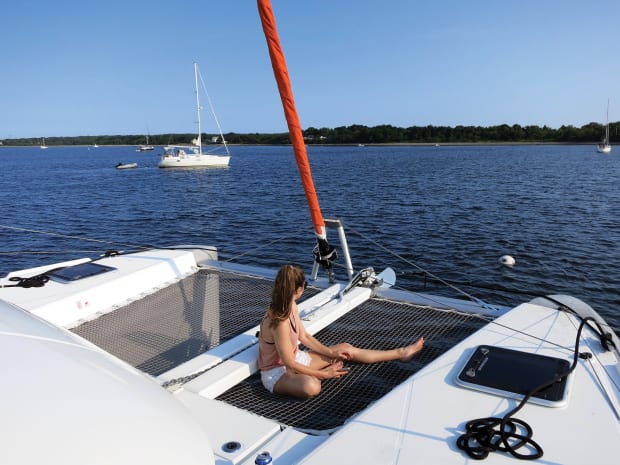
Photo by Michaela Urban
Rhode Island’s Narragansett Bay is a sailor’s paradise, not only because of its vast expanse of sheltered water, coves and seaside towns, but because of the many nearby destinations it offers as well. The last time a group of friends and I chartered out of Narragansett Bay, we used it as a base for an amazing tour of Nantucket, Martha’s Vineyard and Cuttyhunk islands. This time we set our sights west.
Of particular interest was Shelter Island off the tip of New York’s Long Island. My Swedish-born great-grandmother, Ingrid, used to have a sprawling home on the shores of this sleepy island, which we used to often visit when I was a small child. Our family stayed in an apartment over the garage, and I have fond memories of rummaging through the treasure trove of anchors, chains, oily motors, ancient tools and other fascinating nick-nacks there. One time I found an old wooden model boat with a miniature electric Evinrude motor that my great grandmother let me keep. Another time my dad boiled a local lobster so big it not only knocked over the pot it was about to be boiled in but almost escaped.
The last time I visited Shelter Island was to lay my grandfather (Ingrid’s son) to rest in the family plot. Over the course of the many intervening years, I’ve often longed to return to the island and pay my respects. This trip, which would include my brother as a member of the crew, would provide an excellent opportunity to do just that. Also on the list of destinations were Block Island, a few other spots in Long Island and some of the many wonderful, historic towns lining Narragansett Bay itself.
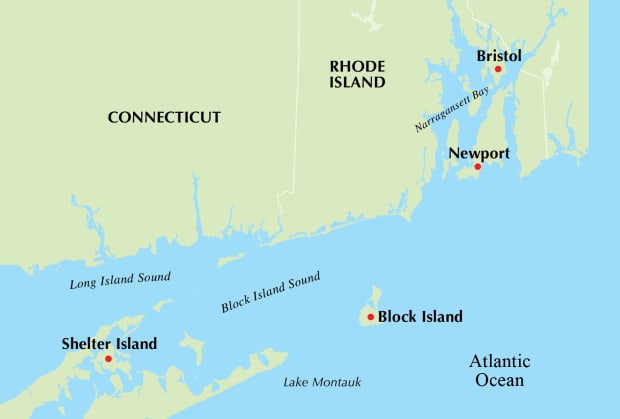
For our adventure, we arranged our charter with Bluenose Yacht Sales (bluenoseyachts.com), based in Newport, Rhode Island, a company that provides a combination of great service and very well-maintained boats. Since we had quite a few people on board, we decided to step up our game and charter a catamaran. Bluenose had just acquired a new Excess 12, which fit the bill and then some, having ample room for both the crew and all our gear. It also proved a wonderful boat to sail.
Weather is always important when sailing, especially in coastal New England. It can really blow, for example, as you pass Point Judith a short distance beyond the shelter of the Narragansett Bay to the west. The swells and currents can also get pretty hairy, making it important to pick a good weather window.
Another thing to consider is the fact that Block Island is a very popular tourist destination and can get pretty crowded on holidays and weekends. Fortunately, in our case, the weather looked good and we were starting our trip a Monday, so after provisioning our Excess 12 with plenty of food, drink and gear, we promptly shoved off.
One of the things I love about sailing these waters is that I studied these same charts for my Coast Guard Masters training and test. It was therefore a real thrill to physically navigate features what I theoretically “knew” so well. I’d like to say that we rolled out the paper charts, dividers and parallel rulers and started calculating distance, currents, drift and rate. But truth be told, we mostly used my iPad and trusty Navionics app. That said, it’s always good to have those “manual” tools handy when electronic devices fail.
For our first night out, we’d booked a slip at Paynes Marine in Bock Island’s Salt Pond, a big lagoon opening out onto the island’s northwest corner. Salt Pond is where most sailors stay when visiting the island. It’s expansive and has a number of marinas, mooring balls and anchor fields. There is another small “town” marina on the eastern side of the island with limited anchoring and dockage. However, it is also the site of the ferry terminal and very busy. My recommendation is to shoot for Salt Pond. Be mindful, though, that it fills up in the summer, even during the workweek, so don’t be late.
Once there, if you’re looking for the party scene, Paynes is the place to go. We got lucky and managed to snag a prime spot right in front of the bar and band. Our boat also got a lot of attention since the design is still fairly new and cruising cats have historically been few and far between in New England, so we made a lot of new friends.
Important to note: slip space comes at a premium on Block Island. If you want to save some money, grab a mooring ball. You can also anchor (in designated areas that are clearly marked), but the anchor fields are pretty crowded. There are plenty of stories of anchor drag at Block Island, due to wind shifts and not enough room to lay down enough chain rode, so be on your guard.
In spite of its popularity, Block Island maintains a healthy down-home feel. A good place to get that feel (and start your day) is Block Island’s favorite local Café Persephone’s. This eclectic and colorful café has a great selection of healthful foods and great coffee. Their “Splendid Egg Sandwich” and “Golden Smoothie” can’t be beat.
After breakfast, we all rented bikes at Beach Rose Bicycles and toured the island. There’s a lot to see here with great vistas and some awesome beaches, so be sure and pack your swimsuit. For dinner, we hit another famous local spot, Kimberly’s, which has great outdoor dining and friendly staff.

One thing I have to say about almost all the places we visited Block is that the folks are really friendly there. This goes against the stereotype for many tourist spots where you often encounter grumpy locals who seem to like tourist money but not so much the people spending it. That does not seem to be the case on Block, or at least if it is, I never experienced it. What I found was a relaxed, accommodating, local feel, which I really appreciated.
Fast forward to the next morning and when we woke, ready to continue on to Long Island, we discovered something else pretty common to these waters—fog. I’m not just talking little sea smoke, here. I mean the pea soup kind of fog where you can see less than 1,000 yards. What experienced mariners call “very poor visibility.”
Luckily, we had factored in a lay day for weather, and since another day in Block was to everyone’s liking, we stayed. Unfortunately, the next morning conditions remained much the same, forcing us to make a decision. It was hard to tell if the fog was just laying over Salt Pond or if it was bad out on the Block Island Sound as well. Crossing our fingers, we took a chance and motored out the channel. Alas, we saw little improvement and therefore headed back in and grabbed another mooring ball, hoping it would burn off in the next hour or so. Luckily things did get better—thinning out to where we felt we could safely head to Long Island. The plan was to check out Sag Harbor and then head over to Shelter Island via land. Part of my nostalgic trip was to take the tiny Shelter Island Ferry, of which I had fond memories as a kid.
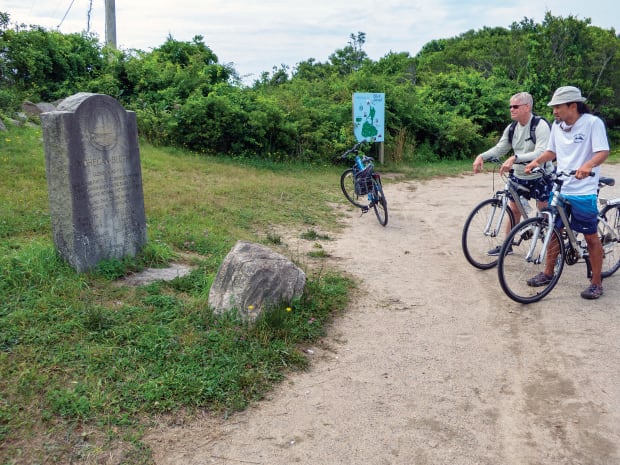
Photo by Michaela Urban
Sag Harbor is a quiet but beautiful little town with a great bagel shop, and the trip to Shelter Island proved to be a fantastic ride down memory lane, as my brother and I paid our respects at our family plot. After that, our pilgrimage completed, it was time to start thinking about the next stage of our charter, during which we planned to head back to Narragansett Bay and check out some of towns seaside towns there.
It was a long haul back to Rhode Island, so we decided to stop for the night midway there in Lake Montauk, a sheltered bay at the very tip of Long Island. There were a couple of other good reasons for taking a break. One was we still had a little fog and were hoping it would lift the following day. Another was we all wanted to check out Montauk Point State Park on the very tip of Long Island.
Conning your way into Montauk Lake can be tricky. The main channel is wide enough and well-marked, but just before you enter the main body of the lake it gets narrow, so keep an eye on those channel marks!
After making our way through, we grabbed a mooring ball and headed out in the dingy to explore. Finding the best place to land the dingy on the beach to access the park was also a bit tricky, and we ended up with a kind of long walk. Eventually, we found the park, which proved to be well worth the trek, as it provided some really nice trails and views of the rugged “end” of Long Island.
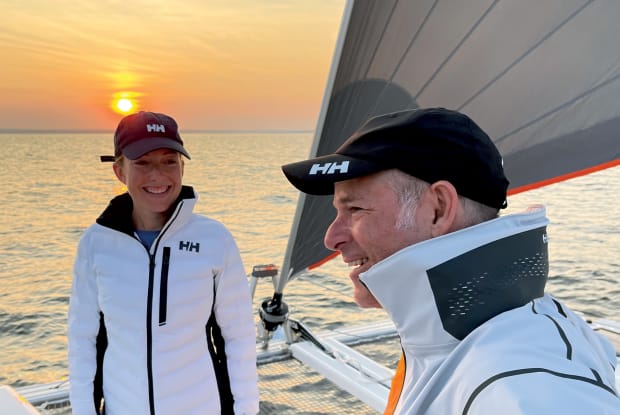
The following morning, knowing we had a lot of miles to cover, we all got up early to assess wind and weather. The fog was still with us, but didn’t seem too bad now, so we dropped our mooring and headed out. Sailing away from Montauk, though, the fog began to come in thick, forcing us to drop sails, turn on the motor and reassess. Luckily, it was safe enough to keep going. Nonetheless, we needed to take precautions, putting watches fore and aft, sounding a prolonged foghorn blast every minute or so and paying close attention to our VHF radio in order to keep tabs on any commercial traffic.
While we did not have radar (most charter sailboats don’t), we did have an automatic identification system (AIS) on board, which proved to be a huge help, as it allowed to keep close tabs on any larger vessels out there that might become a problem. Our biggest worry was the scattering of small recreational fishing boats in the area. Many of these don’t have radar, can’t see AIS and tend to run at high speeds.
Despite the fact it was slow going and a long haul, we had little problem making it into Narragansett Bay well before sunset. Our final challenge of the day was navigating a huge regatta taking place on the northern side of the Newport Bridge, in the still thick fog. Once through that, though, we had no problem continuing on into Bristol, where we grabbed a mooring balls in the Bristol Town Marina. The folks at the marina were both helpful and friendly. Their offices are in an impressive stone-castle-like old armory building.
Bristol is a wonderful, historic seaside town, replete with some great old homes wonderful restaurants. After getting a bit to eat and stretching our legs a bit, we headed over to the Herreshoff Marine Museum, dedicated to the history of the Herreshoff Manufacturing Company. Herreshoff, of course, produced dozens of legendary and internationally recognized sailing yachts and steam-powered vessels between 1878 to 1945. Founded by John Brown Herreshoff (a blind local boatbuilder) and his younger brother, Nathanael Greene Herreshoff (a naval architect and steam engineer), they initially gained considerable fame as builders of some of the world’s fastest steam yachts and torpedo boats. However, it was their outstanding racing and cruising sailboats that earned the company its most enduring legacy. Among these were a number of winning America’s Cup designs and a whole host of other cutting-edge raceboats.
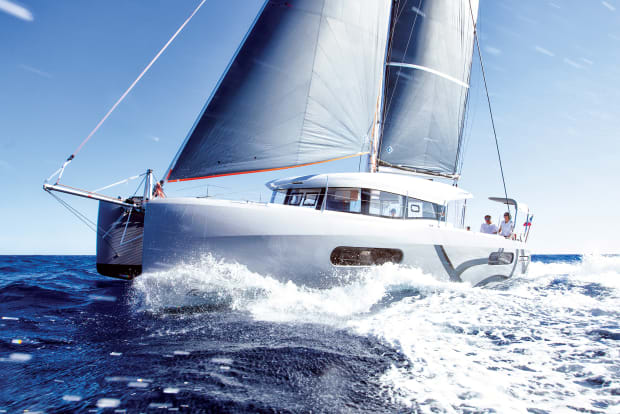
Photo courtesy of Excess
After that, our last stop before having to return our boat to Bluenose Yachts in Newport was the town of Wickford, another historic town with dozens of beautifully maintained, classic New England homes. The inner harbor has a very narrow channel with a lot of boat traffic, so we decided to take a ball outside of the main channel and dinghy in.
In order to better appreciate the town’s history, the folks here have added a nice touch to its many amenities, mapping out a great little walking tour. Alas, there’s never enough time on a charter to do all you want to do, and I would’ve loved to have another week just to gunkhole around Narragansett Bay, but it was time to return the boat. This is the second time I have used Rhode Island waters as a hub for great sailing destinations, and I’m sure I’ll do it again. Who would have thought America’s tiniest state would have so much to offer?
Ed note: If you want to charter the Excess 12 the author sailed or any of the other new Jeanneaus in the Bluenose Yacht Sales fleet, call Steve Fischer at 401-300-2988 or e-mail steve@bluenoseyachts.com
April 2022








